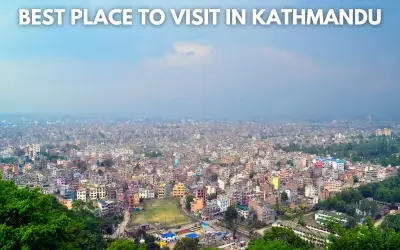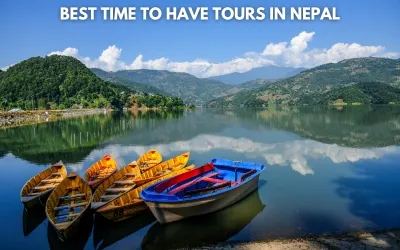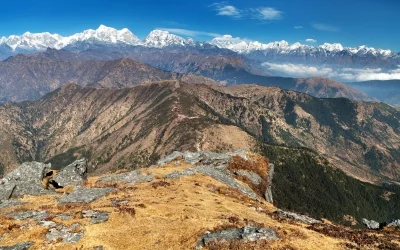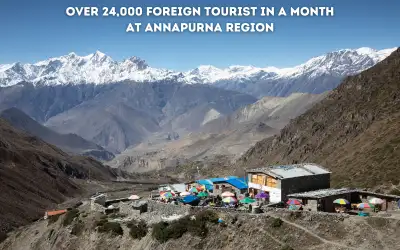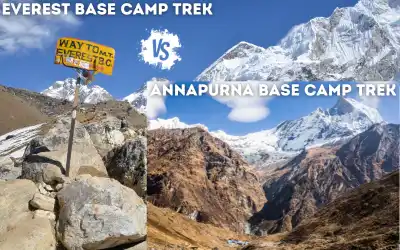Everest Base Camp Trek Difficulty
October 16, 2023Everest Base Camp Trek Difficulty
- Everest Base Camp Trek Difficulty
- About Everest Base Camp Trek
- Why is the Everest Base Camp Trek difficult?
- Can a beginner trek Everest Base Camp?
- How long does it take to prepare for the Everest Base Camp Trek?
- Climate in Everest Region
- Packing List To Minimize Everest Base Camp Trek Difficulty
- Everest Base Camp Trek Cost
- Lastly, Is The Everest Base Camp Trek Worth It?
The Everest Base Camp Trek is one of the most popular trekking routes in Nepal and takes you on an amazing journey amidst the Himalayas to the ultimate Everest Base Camp.
But do you know how difficult the Everest Base Camp Trek is? The difficulty of the Everest Base Camp Trek is as concerning as its popularity.
Trekking to the Himalayas is one of the best experiences, yet it has several difficulties. The main difficulty of the Everest Base Camp trek lies in the altitude sickness.
As Everest Base Camp trek difficulty is a concerning factor, in this blog we will go through a descriptive overview of why the EBC trek is difficult and tips to overcome difficulties during the trek.
About Everest Base Camp Trek
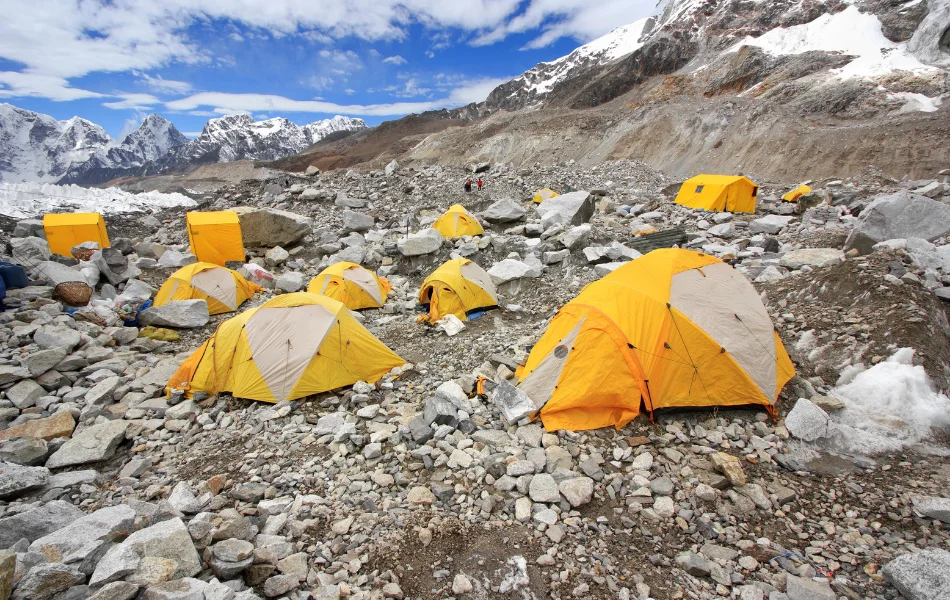
Everest Base Camp Trek is a 12-16 days of the trek to the Himalayas that offers you views of the iconic mountain ranges, including Mt. Everest, Mt. Lhotse, Mt. Ama Dablam, etc.
The trek generally starts in Kathmandu with a scenic flight to Lukla. Most flights to Lukla from Kathmandu are operated in September but in October, they are operated from Ramechhap airport.
The trek then begins from Lukla, which is also called the gateway to the Khumbu region. The trekking distance from Lukla to Everest Base Camp is approximately 65 kilometers (40.3 miles).
The route of the Everest Base Camp Trek then continues to different Sherpa villages. Some of the major destinations you will visit on the trek are Phakding, Namche Bazaar, Tengboche, Dingboche, Lobuche, Pheriche, Gorakshep, and Kala Patthar.
Everest Base Camp Trek Itinerary Overview | |
| Day 01 | 40-50 minutes of Scenic flight to Lukla from Kathmandu and Trek to Phakding (5–6 hours) |
| Day 02 | Trek from Phakding to Namche Bazaar (5 to 6 hours) |
| Day 03 | Acclimatization at Namche Bazaar (3,440m) |
| Day 04 | Trek to Tengboche from Namche Bazaar (5 to 6 hours) |
| Day 05 | Trek from Tengboche to Dingboche (5 to 6 hours) |
| Day 06 | Trek to Lobuche from Dingboche (6 to 7 hours) |
| Day 07 | Trek to Gorak Shep from Lobouche (2.5 to 3 hours), take a short break and then trek to Everest Base Camp (2 to 3 hours), returning to Gorak Shep |
| Day 08 | Early morning trek to Kala Patthar (1.5 to 2 hours) and return to Gorak Shep to continue the trek to Pheriche (6 to 7 hours) |
| Day 09 | Trek from Pheriche to Namche Bazaar (6 to 7 hours) |
| Day 10 | Trek to Lukla from Namche Bazaar (7–8 hours) |
| Day 11 | Fly back to Kathmandu from Lukla |
Note: This is a classical route to Everest Base Camp that has less difficulty within the journey. This itinerary doesn’t include the days in Kathmandu and the departure day. | |
With this trek, you will be able to accomplish the height of the Everest Base Camp alongside an amazing journey through majestic mountain peaks.
Situated at an elevation of 5,364m (17,598ft), the Everest Base Camp offers a spectacular viewpoint of the world’s largest mountain peak, Mt. Everest, with other nearby peaks.
Why is the Everest Base Camp Trek difficult?
The Everest Base Camp Trek is difficult because of the elevations you have to cover throughout the trek. Starting from Lukla, the elevation increases from 2,860m all the way up to 5,364m of the EBC.
At higher altitudes, there is a high possibility of getting acute mountain sickness (AMS). Unlike age or fitness level, mountain sickness can affect anyone at any time.
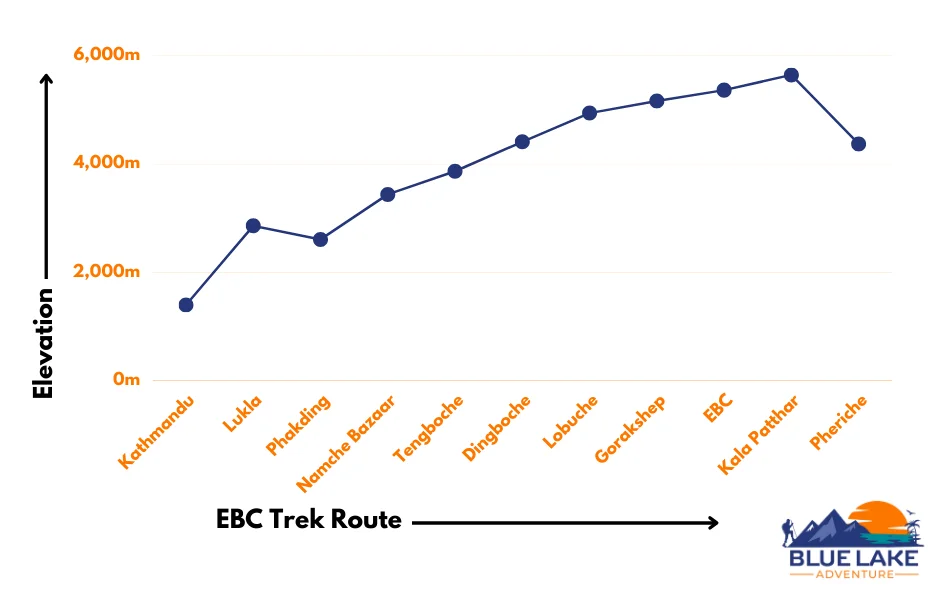
Is altitude sickness dangerous on the Everest Base Camp Trek?
Yes, altitude sickness is dangerous, as it is common and can affect anyone when you reach an elevation of over 2,500m. And, as the EBC trek involves trekking to higher altitudes over 3,000 meters, altitude sickness is more of a risk factor.
If the altitude sickness is not treated at the right time, it can lead to fatal problems. Basically, there are 3 stages of altitude sickness: acute mountain sickness (AMS), high altitude pulmonary edema (HAPE), and high altitude cerebral edema (HACE).
But how do I know if I have altitude sickness or not? Altitude sickness can affect anyone at higher altitudes, so if you feel headaches, nausea, fatigue, dizziness, trouble sleeping, or difficulty breathing, then you are most likely to be affected by the sickness.
They are common in people who are not acclimatized, meaning they are not used to breathing at higher altitudes or in thin air.
Minimizing the risk of getting altitude sickness is important. During the Everest Base Camp trek, you can acclimatize at Namche Bazaar for a day to get familiar with the thin air at higher altitudes.
Here are additional tips to prevent altitude sickness during the Everest Base Camp Trek:
- Acclimatize properly: Acclimatization is most important, as before gaining more altitudes, it is important to familiarize the body with breathing at higher altitudes.
- Drink plenty of water: To avoid the potential risk of altitude sickness, drinking plenty of fluids is important. Dehydration can make the sickness even worse. During the trek, carry a water bottle of 3-5 liters and aim to drink all in a day.
- Get enough sleep: Sleep is important for recovery and acclimatization. It is better to sleep for 7-8 hours per night.
- Listen to what body says: It is important to consider what your body is saying. Take rest if it is needed. If you start to feel any symptoms of altitude sickness, such as headaches, dizziness, nausea, or shortness of breath, stop and rest. Descend to lower altitude if the symptoms don’t improve.
- Avoid alcohol and caffeine, as they dehydrate you.
- Trek breaks frequently; it is better to take rest after 30-60 minutes of hiking to stop and catch your breath.
Other Additional Difficulties
Other than altitude sickness arising from the thin air at higher altitudes, there are additional potential risk factors that can make the EBC trek difficult.
Some of the major Everest Base Camp Trek difficulties are distance, rugged terrain, unstable weather, crowds, and physical fitness.
Distance and Terrains
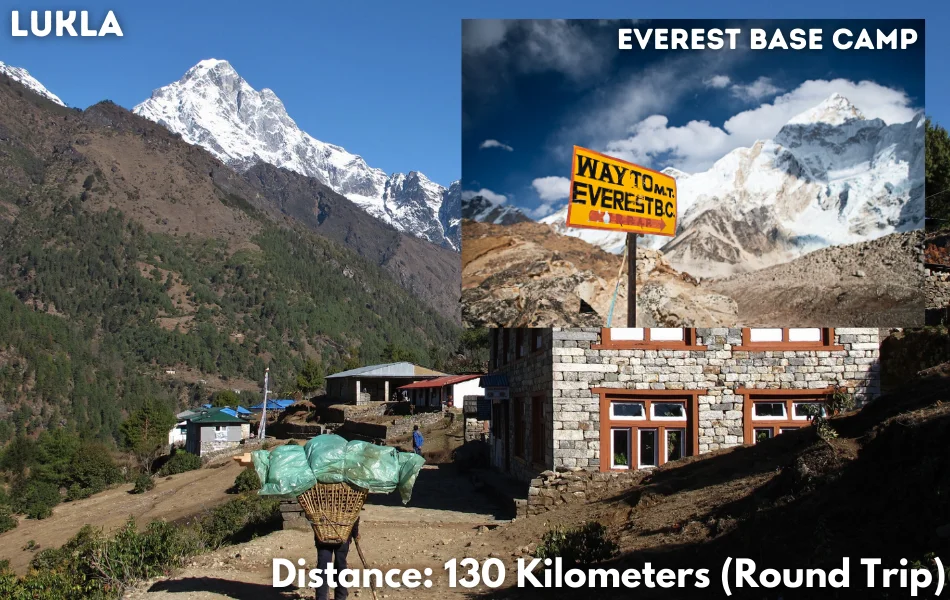
The Everest Base Camp Trek is a relatively long trek that takes a minimum of 12 days for the overall trek. Starting from Kathmandu, as it is a flight route to Lukla, there is no difficulty in the beginning.
But when the trekking starts, you are required to hike for an average of 6 hours per day. Although you will have frequent breaks every 30-60 minutes of hiking, trekking for 6-7 hours can be tiring for older age groups.
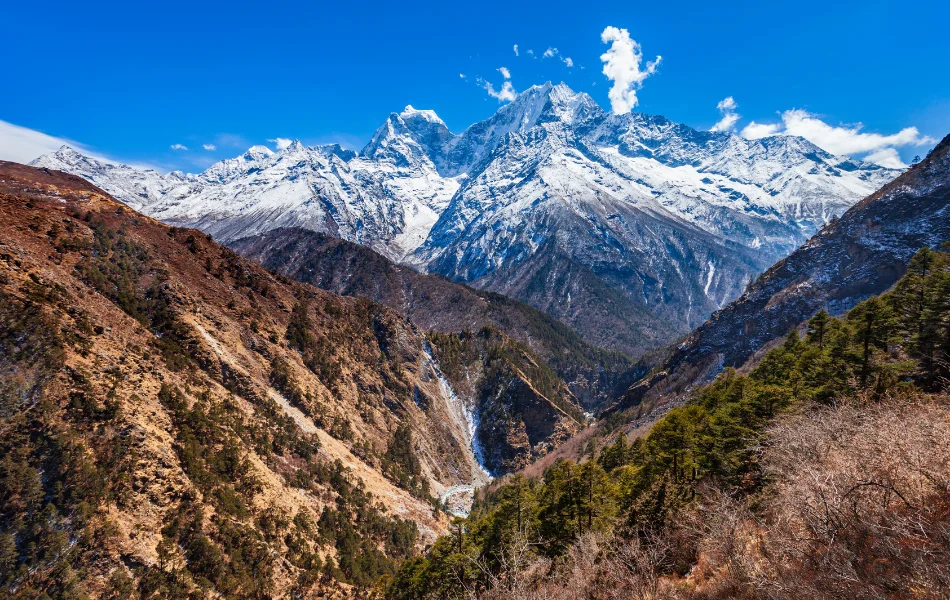
The trek is almost 130 kilometers (80.6 miles) round-trip, and it covers a variety of terrain, including steep climbs, rocky trails, and river crossings.
If you haven’t trekked on the terrain of Nepal, then the Everest Base Camp Trek is most likely going to be more difficult for you.
Haven’t you trekked to EBC before? Here are 8 tips for beginners to follow that will help you have a better trekking experience.
Sudden Weather Change
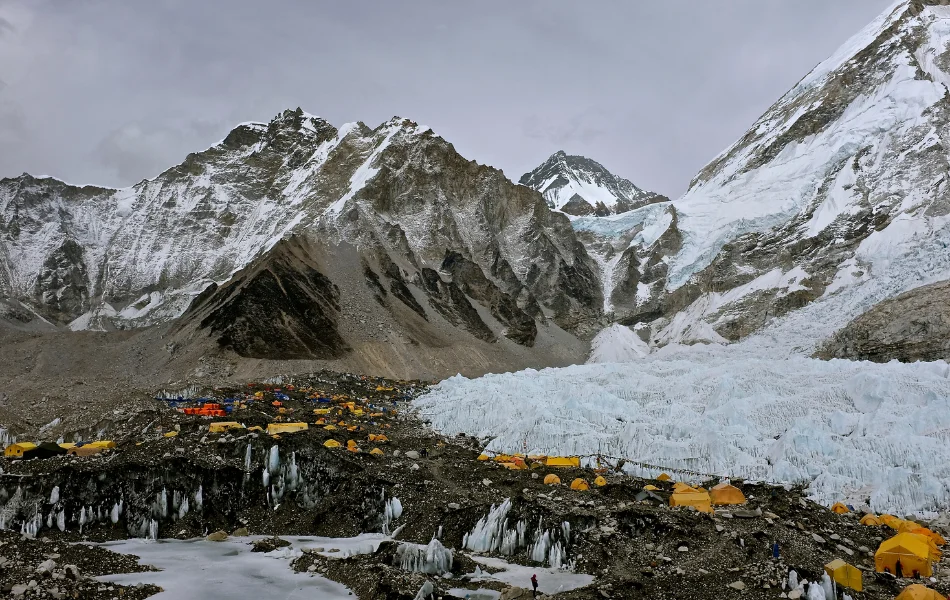
Sudden weather changes are one of the most challenging factors in the Everest Base Camp Trek. The Himalayas of Nepal often face sudden weather changes that are more likely to affect trekkers.
Though the weather change is less likely to be possible in the spring and autumn seasons, it is still a concerning factor as they are generally unpredicted.
You might experience snowfall, rain, or a foggy view as a result of the weather change, which makes the trek more challenging.
To avoid the sudden change in the weather, choosing an ideal time is important. The monsoon and winter seasons are more challenging because they don’t have a suitable climate.
Do you know? April is one of the best months to do the Everest Base Camp Trek. Find out here why April is the best month to have the EBC Trek.
Crowds
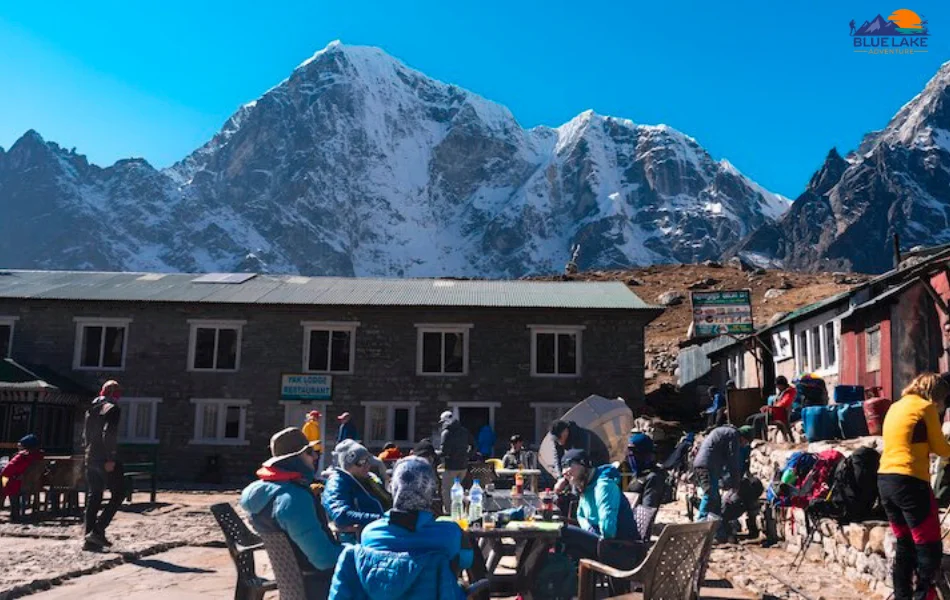
Crowds are yet another serious difficulty in the Everest Base Camp Trek. It can be difficult to hike on rugged terrain and steep pathways if there are more people hiking.
During the peak seasons of trekking in Nepal, you can expect more crowds on the trails and teahouse.
There are chances of not getting better accommodation during the trek in peak seasons because of the crowds.
Also, you are likely to miss views from different viewpoints because of the crowds. It is recommended to go in the early days of the peak season, as there are fewer crowds.
Physical Fitness
As the Everest Base Camp Trek requires trekking for an average of 6 hours per day, it is important to have a better physique.
If you don’t have better physical fitness, then you can face a lot of difficulties, like not being able to hike for hours or match the pace of your companion.
Having better physical fitness is as important as preventing altitude sickness. In addition, the terrain is rough on the EBC trek, which requires better physical fitness.
For the Everest Base Camp Trek, the more fitness you have, the easier and more comfortable the trek will be.
So, to have a better experience trekking to Everest Base Camp, you have to be fit enough to handle the changing temperature and hike for an average of 6 hours a day.
Can a beginner trek Everest Base Camp?
As a beginner in trekking, it is hardly possible, as you need to have better knowledge of how you can possibly make the trek easier.
I can’t say it is impossible for a beginner to trek Everest Base Camp but it is not suggested for beginners to aim for the EBC trek on their first go.
There are various beginners friendly treks, short hikes from Kathmandu and treks from Pokhara that can be done easily within 2-3 days.
It is important to have experience trekking in the landscapes of Nepal if you are planning to trek to Everest Base Camp. Leaving the Everest Base Camp, you can go on the Annapurna Base Camp Trek, which doesn’t require that much active experience.
Not suggested, but yes, beginners too can make the trek to Everest Base Camp. But they need proper guidance as well as strong determination, as this trek continues for more than 12 days.
For beginners, we have the 8 best tips to trek to Everest Base Camp. Following these additional tips, beginners can make the trek to EBC.
How long does it take to prepare for the Everest Base Camp Trek?
It is important to be mentally and physically prepared for the Everest Base Camp Trek. Mentally prepared, as in, you need to have strong determination to complete the trek without thinking once of giving up on the way.
Whereas, getting physically fit is equally important for the Everest Base Camp Trek. You need to have better physical strength in your body, especially in your legs, to be able to walk for hours on the trails.
For the question, how long? If you are mentally fit and prepared, thinking of completing the trek even when the difficulty occurs, then you are good to go for the trek.
Whereas for being physically fit, if you have a good fitness level, then regular exercise for a maximum of 2 months is beneficial. A short walk in the morning, cycling and swimming can help you maintain your fitness.
Lastly, preparing after landing in Nepal is also important. You have to be prepared with good and proper trekking gear and other personal items, including permits and flight tickets.
It is recommended to book flights early if you are traveling during the peak season. The crowds are much higher during the peak seasons, which can lead to not getting a flight to Lukla or paying extra for booking an occupied seat.
Also, if you think these are hassles, you can get the Everest Base Camp Trek package with Blue Lake Adventure. We provide the 13 days itinerary with everything included, like permits, accommodation, food, guide porters, and flight tickets.
For inquiries, you can email us at info@travelagencyinnepal.com!
Climate in Everest Region
The climate in the Everest Region is dependent on the seasons, as the different seasons offer different climates. There are four seasons, monsoon, autumn, winter, and spring.
Whereas the monsoon and winter are not considered the best seasons to have the Everest Base Camp Trek as the climate during these seasons is harsh.
The monsoon season receives heavy rainfall and it is almost impossible to trek to Base Camp. On the other hand, nights in the winter are at a negative degree Celsius.
It is possible to trek in winter but due to heavy snowfall and extreme cold, the difficulty is even higher at this time.
And then, the autumn and spring. They are the most favorable and best seasons to do the Everest Base Camp Trek. With the stunning visuals of the different iconic peaks of height over 8,000m, you will be left stunned.
Moreover, the weather in these seasons is clear and sunny, offering the most suitable time for hiking outdoors. You can even encounter several wildlife species during the trek.
In addition, this season offers the best time to experience the cultures of the Himalayan people, i.e., the Sherpa community. They are friendly and the hospitality is one of the best things you can experience.
Talking about the temperature, the Everest Region’s temperature in autumn and spring during the day is around 10°C to 15°C (50-59°F) and -5°C to -15°C (23-4°F) at night.
Packing List To Minimize Everest Base Camp Trek Difficulty
Having better gear and equipment is an important aspect of trekking to Everest Base Camp. Carry a light back and hire a porter so that you can trek freely without putting stress on your body.
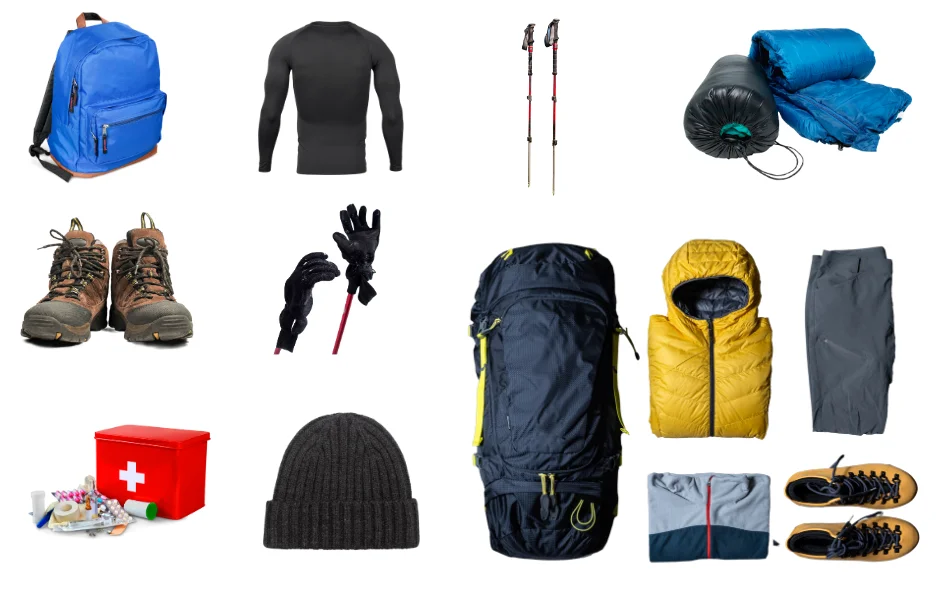
Here is a packing list of gear and equipment that will help you minimize the difficulty arising throughout the trek, making it easier and more comfortable.
Packing list for Everest Base Camp Trek | |
| Clothing | Base Layers: 2-3 long-sleeve shirts and 2-3 long pants made of moisture-wicking materials (merino wools) |
| Insulation layers: 1-2 fleece jackets or sweaters | |
| Outer layers: 1 waterproof jacket and pants with a hood | |
| Hiking shirts and shorts | |
| Underwear and socks | |
| Beanie, neck gaiter, and gloves | |
| Sunglasses and a sunhat | |
| Footwear | Sturdy, waterproof hiking boots |
| Trekking shoes and sandals (camp shoes) | |
| Gear | Trekking poles |
| Daypack (30-50 liters) | |
| Duffel bag (65-75 liters) | |
| Sleeping bag rated to -18°C/0°F | |
| Headlamp with extra batteries | |
| Water bottles or hydration bladders | |
| Water purification tablets or filters | |
| Sunblock and insect repellent | |
| First-aid kit | |
| Toiletries | |
| Camera and Charger | |
| Money (Nepali rupees) and other essential documents (permits, passport, travel insurance, etc.) | |
Everest Base Camp Trek Cost
The cost of the Everest Base Camp Trek is dependent on the season you are trekking, the services you choose to go for, booking with an agency or hiring a guide.
If you are trekking individually, hiring a guide and porter, then it will cost you roughly around USD 600 to USD 800 for 11/12 days of trekking, excluding the flight tickets.
For a descriptive overview, the trek to the Everest Base Camp can cost you a minimum of USD 60 per day, including the guide and porter, as they charge on the day basis.
If you are trekking to Everest Base Camp, then you probably shouldn’t miss the cost breakdown of the overall trek and the tips to save money during the trek. Here’s the blog for this; check it out and find out the overall cost breakdown for the trek to Everest Base Camp.
Lastly, Is The Everest Base Camp Trek Worth It?
For trekking enthusiasts, nature lovers and those who want to discover the undiscovered part of Nepal, the Everest Base Camp Trek is definitely worth the money and time.
With just 12-17 days of trekking, you can explore different well-known destinations in the Khumbu region and the base camp.
This trek takes you to the very end of Nepal’s viewpoint to watch the stunning, clear panoramic views of Mt. Everest, which is also called the tallest mountain in the world.
Whether it is having glimpses of the mountain ranges throughout the trails, enjoying every moment on the trails, or visiting the local Sherpa villages, the Everest Base Camp Trek has everything to make the trek worthwhile.
Here, we have come to the end of the blog on Everest Base Camp Trek difficulty. If you are planning to trek to EBC, then make sure you consider these difficulties and the tips to avoid them.
Also, if you wish to get the Everest Base Camp Trek package or any packages for different regions in Nepal, then make sure you check out the itineraries, packages included and why Blue Lake Adventure is trekking in Nepal.
Reach out to us through our contact page, emails or by sending a WhatsApp message at +977 9851076943.



